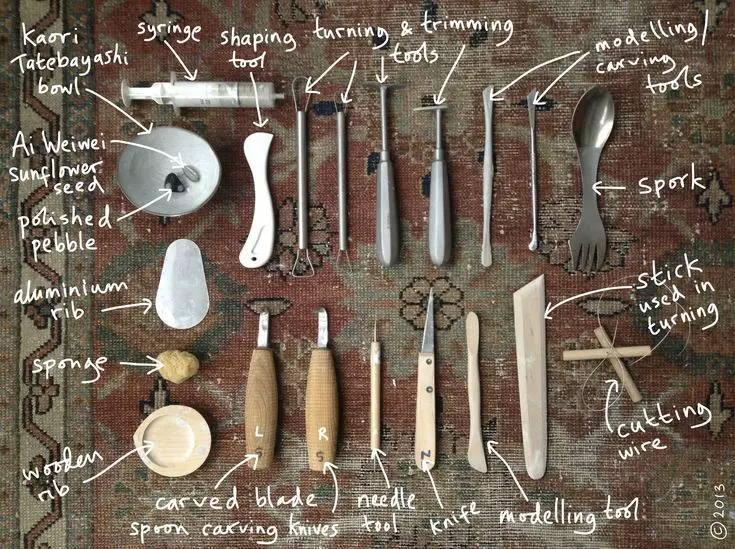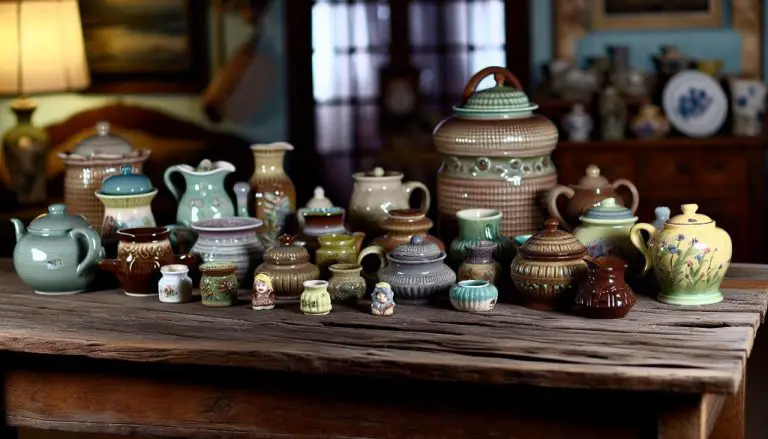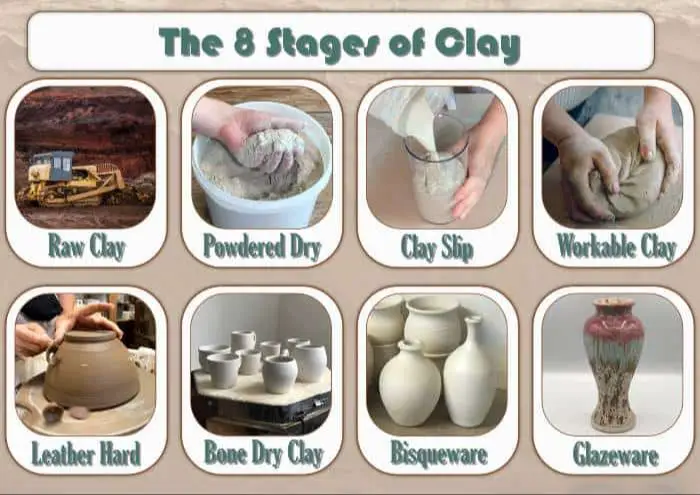Is Pottery And Ceramics The Same Thing?
Pottery and ceramics are often used interchangeably, but there are some key differences between the two. Pottery refers specifically to objects made from clay that have been hardened by firing at high temperatures. Ceramics is a broader term that encompasses pottery as well as other items made from non-metallic and inorganic materials.
The goal of this article is to analyze the similarities and differences between pottery and ceramics. We will examine their materials, production methods, types, and uses in order to gain a deeper understanding of how they are related yet distinct. By the end, you should have a clear sense of what defines each one and when it is appropriate to use the terms “pottery” or “ceramics.”
History
The origins of pottery and ceramics date back thousands of years. Archaeological evidence shows that primitive pottery vessels made from clay were being created and used during the Upper Paleolithic period, around 30,000 years ago. The oldest known pottery fragments were found in China and Japan, dating to 12,000 – 16,000 BCE. Primitive pottery vessels were hand-built, using the coil method, and fired at low temperatures in open fires or pits. The earliest known ceramic objects were simple earthenware figurines made of fired clay, dating to around 25,000 BCE. History of Pottery: Ceramics, Earthenware Porcelain, and …
Early pottery was mainly functional – used for storage, cooking, and transporting food and water. Decorations were minimal at first but became more elaborate over time. Ceramics were also used early on for ceremonial and religious artifacts. The development of the potter’s wheel around 6,000 BCE revolutionized how pottery was produced, enabling far more uniform pieces to be quickly made. The first glazes were added to pottery around 4,000 BCE to improve water resistance and aesthetics. Different clays, glazes and firing techniques steadily improved over thousands of years, allowing potters to create more diverse and complex forms of pottery and ceramics.
Materials
The primary material used in both pottery and ceramics is clay. However, the exact composition of the clay varies. Pottery typically uses earthenware clays that have lower firing temperatures, while ceramics often use stoneware or porcelain clays that can withstand higher firing temperatures.1 Earthenware clay contains a higher percentage of iron and other impurities and has a coarser texture, while porcelain clay is extremely refined and can be translucent after firing.2 Stoneware falls somewhere in between.
In addition to clay, pottery and ceramics may also incorporate other materials such as glazes, oxides for coloring, and additives like grog (ground up fired clay) to improve durability and workability. Ceramics in particular may mix in glass, minerals, or other substances to create specific properties.
Production Methods
There are several key production methods used in pottery and ceramic creation.
Forming is one of the first steps, which involves shaping the clay. Pottery can be formed using a pottery wheel, through handbuilding techniques like coiling, slabbing, pinching, or throwing on the wheel. Ceramics may use these techniques as well, along with casting or jiggering using molds.
Glazing provides a protective coating and decorative finish. Pottery and ceramic pieces are often glazed by applying a liquid glaze suspension to bisqueware (unglazed clay that has been fired once). The glaze melts during firing and fuses to the clay body. Glazes come in various colors and textures.
Firing is the process of heating pottery or ceramics in a kiln. Firing dries the pieces, sets any glazes, and permanently hardens the clay body through sintering. Different firing temperatures yield different properties. Raku firing and pit firing, for instance, use lower temperatures and special techniques to create unique pottery finishes.
Overall, while the specific techniques may vary, pottery and ceramic production utilizes forming, glazing, and firing processes to shape, decorate, and harden clay into a final product.
Types of Pottery
There are several main types of pottery, each with their own characteristics and uses:
Terracotta
Terracotta is an unglazed, porous earthenware made from clay. It is usually red or brownish-orange in color from the iron oxide pigment in the clay. Terracotta has been used for pottery and sculptures since ancient times. It is inexpensive, durable, and able to withstand high temperatures which makes it ideal for items like plant pots and decorative figures.
Earthenware
Earthenware is a common type of pottery made from clay fired at lower temperatures compared to other types. It is opaque, can be glazed or unglazed, and more porous than stoneware or porcelain. Earthenware has been produced for thousands of years across the world. It is used for a wide variety of items from tableware to decorative objects.
Stoneware
Stoneware is a vitreous or semi-vitreous ceramic made from clay and fired at high temperatures. The higher firing temperatures make stoneware less porous and more durable than earthenware. Stoneware maintains its strength when used as ovenware. It is also valued for decorative items, tableware, and art pieces.
Porcelain
Porcelain is a ceramic material made by firing clay and other minerals at very high temperatures. It is highly vitrified, translucent, and white in color. The fine kaolin clay used gives porcelain a delicate, smooth texture. Porcelain is known for its strength, hardness, whiteness, translucency and resonance. It is commonly used for art objects, tableware, sanitaryware and electrical insulators.
Types of Ceramics
Ceramics can be divided into two main categories: traditional ceramics and advanced or technical ceramics.
Some of the most common types of traditional ceramics are:
- Tiles – Glazed ceramic tiles are one of the most widely used traditional ceramics and are commonly used to cover walls, floors, and even roofs. Tiles provide durability and easy cleaning abilities. Sources: https://www.xometry.com/resources/materials/ceramics/, https://farandaway.co/blogs/the-artisan/types-of-ceramics
- Sanitaryware – This includes ceramic fixtures used in bathrooms and kitchens such as toilets, sinks, and bathtubs. Sanitaryware provides hygiene, durability, and aesthetics. Sources: https://www.xometry.com/resources/materials/ceramics/, https://farandaway.co/blogs/the-artisan/types-of-ceramics
- Tableware – Ceramic dishes, plates, bowls, and cups used for serving food and drink. Provides aesthetics, durability, heat resistance. Sources: https://www.xometry.com/resources/materials/ceramics/, https://farandaway.co/blogs/the-artisan/types-of-ceramics
Advanced or technical ceramics have precisely controlled composition and are processed to develop specific properties and performance characteristics. Some examples are:
- Electrical ceramics – Used in electronics for insulation, capacitors, piezoelectrics, etc. Provide electrical insulation, high dielectric strength. Sources: https://www.xometry.com/resources/materials/ceramics/, https://www.thecrucible.org/guides/ceramics/
- Ceramic fibers – Used for insulation, friction products, textiles. Provide high temperature stability, low thermal conductivity. Sources: https://www.xometry.com/resources/materials/ceramics/, https://www.thecrucible.org/guides/ceramics/
Uses
Pottery and ceramics have many different uses, both functional and artistic. Pottery tends to be more focused on functional uses, as it is made from porous clay that can hold liquids. Common pottery vessels include cups, mugs, bowls, plates, jars, and vases. These are often used for cooking, serving food, and storing liquids. Pottery can also be decorative, with glazes and paintings applied for visual appeal. However, the porous nature of pottery makes it less suitable than ceramics for purely decorative items.
Ceramics encompass a wider range of uses. While ceramics can also be functional, like pottery, non-porous ceramics are often favored for decorative wares like figurines, sculptures, and wall tiles. The non-porous nature of some ceramics makes them more durable and water-resistant than porous pottery. Ceramics are also used to create industrial products like electrical insulators, ceramic engineering parts, and ceramic tiles. Some ceramics, like stoneware, are semi-porous and used to create everyday dishware. So while pottery focuses on porous functional vessels, ceramics have both porous functional uses and non-porous decorative/industrial uses.
In summary, the main distinction is that pottery emphasizes functional porous vessels, while ceramics cover a broader range from porous dishware to non-porous decorative and industrial wares.[1]
Similarities
While pottery and ceramics have some key differences, there are also many similarities and areas of overlap between the two crafts. Some of the main similarities include:
Overlap in materials – Many of the core materials used are the same for both pottery and ceramics, such as clay, glass, and silica. The types of clay may differ, but clay is a foundational material for both crafts.
Overlap in production methods – Pottery and ceramic objects are shaped and formed using similar techniques, such as throwing on a pottery wheel, molding, hand-building, and slip-casting. The drying and firing processes also share similarities between pottery and ceramic production.
Overlap in types – There are many specific types of pottery that would also be classified under the broader ceramics category, such as stoneware, earthenware, and porcelain. Likewise, some ceramic types like stoneware and porcelain are also considered pottery.
Overlap in uses – Pottery and ceramic objects share common household and decorative uses, including vessels for cooking, serving food, storing liquids, and displaying as artwork. Ceramic tiles and pottery vessels, for example, both have long histories of utilitarian use.
While the lines between pottery and ceramics aren’t always clearly defined, their similarities in materials, production, types, and uses reflect the close relationship between the two crafts. Many pieces could be described as either pottery or ceramics without a clear distinction. Their shared roots provide a unifying foundation.
Differences
While pottery and ceramics overlap in many ways, there are some key differences between the two art forms:
Moldability: Pottery is typically hand-formed and molded by the artist, allowing for more fluid and organic shapes. Ceramics often utilize more precise mechanical processes and molds for mass production.
Firing Method: Pottery is often fired at lower temperatures, usually below 1200°C. Ceramics are typically fired at higher temperatures above 1200°C to vitrify the clay into a non-porous material.
Decoration: Pottery is decorated using techniques like carving, slip trailing, or glazing. Ceramics employ more industrial techniques like screen printing for decoration.
Porosity: Pottery retains some porosity after firing, while ceramics are non-porous and waterproof after high firing temperatures vitrify the clay.
Fragility: Pottery tends to be thicker and less prone to breakage. The vitrified nature of ceramics often makes them more brittle and fragile.
Purpose: Pottery is largely decorative and artistic. Ceramics have more industrial and functional applications like tiles, sanitaryware, tableware, etc.
Conclusion
In summary, while pottery and ceramics use similar materials and techniques, there are some key differences between the two. Pottery tends to refer to functional earthenware like pots, dishes, and vases made from clay and hardened by firing. Ceramics is a broader term encompassing all objects made from clay and non-clay materials that are hardened by firing, including pottery as well as art objects, tiles, and technical ceramics. While there is overlap, ceramics has a wider range of applications and includes more specialized materials and firing methods beyond just clay. Both pottery and ceramics play an important role in culture, art, industry, and archeology around the world. Their longevity is a testament to human creativity and ingenuity.




